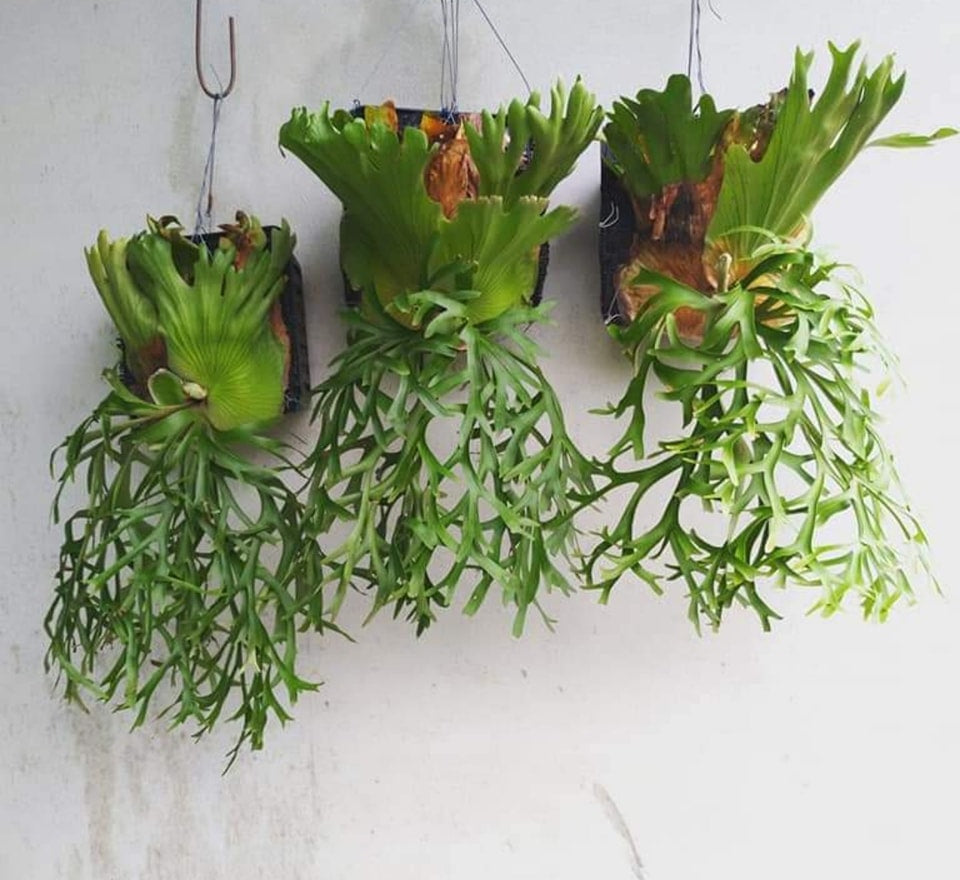One of the deer horns with a designation that originates from the appearance of the plant is the Platycerium coronarium. This staghorn is known for the unusual growth habit of its leaves. Many deer horns embrace the plant on which they grow epiphytically (on or against it without drawing nutrition from the plant).
Origin of the Platycerium coronarium
The Crown staghorn fern is originally from areas around Myanmar and the Philippines. But nowadays, there are more and more areas where the plant is kept or cultivated around the world. In the right, tropical climate, the plant can also hang outside. Can you imagine how special that is to have such a cool plant hanging in the garden?
Characteristics of the Coronarium
The Platycerium coronarium is pleasing to the eye and can be very impressive as a mature plant. The fertile leaves, which contain spores, hang down like a veil. These are the leaves that resemble antlers. This is where the genus gets its name: staghorn or Platycerium.
Leaves in the shape of a crown
This plant has blue blood you would say with the impressive sterile leaves of this staghorn. These grow upward in the shape of a beautiful crown.
Appearance of young plants
When the Platycerium coronarium is still young, it looks even less impressive. This makes the transformation even more special, as the difference can be great as the plant ages. Indeed, at an early stage, the plant will show only the sterile leaves (funnel leaves), which will grow in a rosette-like manner.
Brown leaves on the Platycerium
A characteristic of this Platycerium is to first grow green and large funnel leaves in a rosette-like manner, but when the antler-shaped fertile leaves develop, these leaves turn inward and slowly begin to be used as nutrients. So these may slowly turn brown in part, but this is not a sign of poor climate or care. This is a natural process whereby the plant composts and "eats" its own leaves to get energy from these for new growth.
Care of the Platycerium coronarium
The coronarium is a relatively easy Platycerium that can grow very large. The fertile, antler-shaped leaves can reach a length of over a meter in the wild. Since this is still a relatively rare plant, more information on this will slowly emerge as to whether this is possible for the hobby grower.
Climate for the coronary staghorn fern
This fern is best kept in a room with high humidity and may be placed in a lot of indirect sunlight. Here the plant may also be placed in a moderate to high temperature and cool a few degrees at night. But drafts and tap water is strictly to be discouraged with this species. Use especially clean rainwater and be careful not to overfeed when giving houseplant food.
Our Platycerium products and method of shipment
Our Platyceriums are usually shipped in pots. In doing so, the plant may sit a bit off the wall and be relatively slightly smaller in relation to the pot. We do this intentionally to protect the plant as much as possible for conditions during transport. After a while of being well acclimated in the new space and showing clear growth, we may choose to re-pot or mount the plant in the ideal growing position against a wooden panel or on a fern block with high quality moss. Since this is not ideal for transportation and our suppliers also ship the plants in pots, we often will not be able to prepare this for you.

